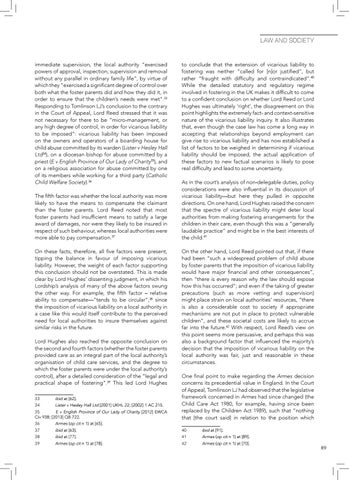LAW AND SOCIETY
immediate supervision, the local authority “exercised powers of approval, inspection, supervision and removal without any parallel in ordinary family life”, by virtue of which they “exercised a significant degree of control over both what the foster parents did and how they did it, in order to ensure that the children’s needs were met”.33 Responding to Tomlinson LJ’s conclusion to the contrary in the Court of Appeal, Lord Reed stressed that it was not necessary for there to be “micro-management, or any high degree of control, in order for vicarious liability to be imposed”: vicarious liability has been imposed on the owners and operators of a boarding house for child abuse committed by its warden (Lister v Hesley Hall Ltd34), on a diocesan bishop for abuse committed by a priest (E v English Province of Our Lady of Charity35), and on a religious association for abuse committed by one of its members while working for a third party (Catholic Child Welfare Society).36 The fifth factor was whether the local authority was more likely to have the means to compensate the claimant than the foster parents. Lord Reed noted that most foster parents had insufficient means to satisfy a large award of damages, nor were they likely to be insured in respect of such behaviour, whereas local authorities were more able to pay compensation.37 On these facts, therefore, all five factors were present, tipping the balance in favour of imposing vicarious liability. However, the weight of each factor supporting this conclusion should not be overstated. This is made clear by Lord Hughes’ dissenting judgment, in which his Lordship’s analysis of many of the above factors swung the other way. For example, the fifth factor – relative ability to compensate—“tends to be circular”,38 since the imposition of vicarious liability on a local authority in a case like this would itself contribute to the perceived need for local authorities to insure themselves against similar risks in the future. Lord Hughes also reached the opposite conclusion on the second and fourth factors (whether the foster parents provided care as an integral part of the local authority’s organisation of child care services, and the degree to which the foster parents were under the local authority’s control), after a detailed consideration of the “legal and practical shape of fostering”.39 This led Lord Hughes 33
ibid at [62].
34
Lister v Hesley Hall Ltd [2001] UKHL 22; [2002] 1 AC 215.
35 E v English Province of Our Lady of Charity [2012] EWCA Civ 938; [2013] QB 722.
to conclude that the extension of vicarious liability to fostering was neither “called for [n]or justified”, but rather “fraught with difficulty and contraindicated”.40 While the detailed statutory and regulatory regime involved in fostering in the UK makes it difficult to come to a confident conclusion on whether Lord Reed or Lord Hughes was ultimately ‘right’, the disagreement on this point highlights the extremely fact- and context-sensitive nature of the vicarious liability inquiry. It also illustrates that, even though the case law has come a long way in accepting that relationships beyond employment can give rise to vicarious liability and has now established a list of factors to be weighed in determining if vicarious liability should be imposed, the actual application of these factors to new factual scenarios is likely to pose real difficulty and lead to some uncertainty. As in the court’s analysis of non-delegable duties, policy considerations were also influential in its discussion of vicarious liability—but here they pulled in opposite directions. On one hand, Lord Hughes raised the concern that the spectre of vicarious liability might deter local authorities from making fostering arrangements for the children in their care, even though this was a “generally laudable practice” and might be in the best interests of the child.41 On the other hand, Lord Reed pointed out that, if there had been “such a widespread problem of child abuse by foster parents that the imposition of vicarious liability would have major financial and other consequences”, then “there is every reason why the law should expose how this has occurred”; and even if the taking of greater precautions (such as more vetting and supervision) might place strain on local authorities’ resources, “there is also a considerable cost to society if appropriate mechanisms are not put in place to protect vulnerable children”, and these societal costs are likely to accrue far into the future.42 With respect, Lord Reed’s view on this point seems more persuasive, and perhaps this was also a background factor that influenced the majority’s decision that the imposition of vicarious liability on the local authority was fair, just and reasonable in these circumstances. One final point to make regarding the Armes decision concerns its precedential value in England. In the Court of Appeal, Tomlinson LJ had observed that the legislative framework concerned in Armes had since changed (the Child Care Act 1980, for example, having since been replaced by the Children Act 1989), such that “nothing that [the court said] in relation to the position which
36
Armes (op cit n 1) at [65].
37
ibid at [63].
40
ibid at [91].
38
ibid at [77].
41
Armes (op cit n 1) at [89].
39
Armes (op cit n 1) at [78].
42
Armes (op cit n 1) at [70].
89
